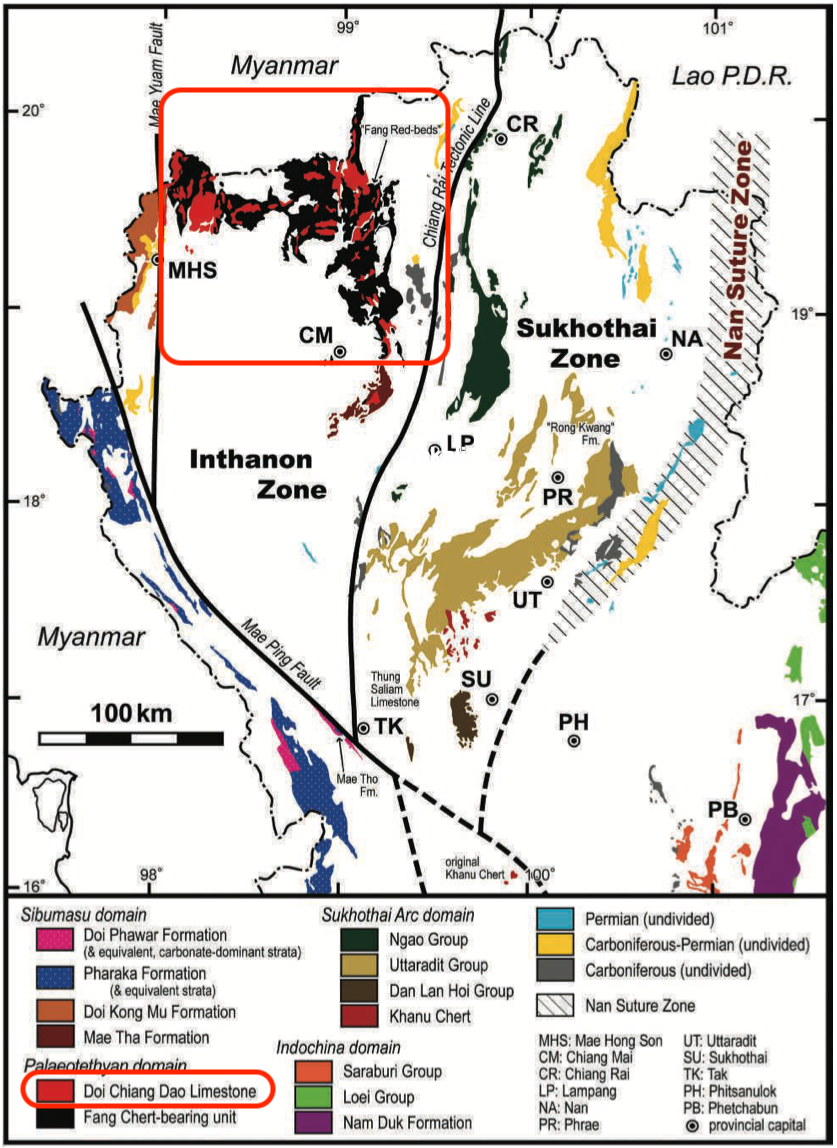Type Locality and Naming
Named after Doi Chiang Dao (a 2194 m high karst mountain west of Chiang Dao) where the type locality is located, Chiang Dao district, Chiang Mai province.
Synonym: หมวดหินปูนดอยเชียงดาว
[Figure: Distribution of Carboniferous and Permian strata in Northern Thailand. Data mainly based on 1:1 million scale geological map of Thailand (DMR 1999) with minor modifications (Ueno K. & Charoentitirat T., 2011, page 75.)]
Lithology and Thickness
Seamount. "Pale-grey massive limestone but partly more dark-colored and moderately bedded particularly in its lower part, with frequent dolomitic levels, and free from siliciclastic materials throughout the thick succession.
The dominant microfacies are bioclastic grainstone, ooid grainstone, oncoidal rudstone and bioclastic packstone, suggesting an open shallow-marine setting. … It is important to note the occurrence of basalt, sometimes showing pillow texture, in what is possibly the basal part of the succession." (Ueno & Charoentitrat, 2011). Thickness: More than 1000 m (rough estimate).
GeoJSON
{"type":"Feature","geometry":{"type":"MultiPolygon","coordinates":[[[[99.44,20.54],[99.56,20.49],[99.55,20.38],[99.52,20.12],[99.41,19.81],[99.28,19.33],[99.08,19.01],[98.86,18.55],[98.85,18.7],[98.91,19.06],[98.9,19.64],[98.92,19.97],[99.09,20.34],[99.44,20.54]]]]}}
Fossils
Various fossils, mostly foraminifers, minor corals and conodonts, have been reported from the Doi Chiang Dao Limestone since the first fusuline and coral records by Japanese student .. Although the data are still fragmentary and from many isolated localities, almost continu- ous Carboniferous – Permian foraminiferal faunas have been recognized from the Doi Chiang Dao Limestone (Fig. 5.5) (Ueno et al. 2008). They have essentially palaeotropical Tethyan affinities." (Ueno & Charoentitrat, 2011)
Age
Carboniferous-Permian (Visean – Induan). "The basal basalt is probably Visean or slightly older judging from the age of the overlying carbonates. … Based on foraminifers, the Doi Chiang Dao Limestone ranges from the Visean (Mississippian/Early Carboniferous) to the Changhsingian (latest Permian), resting upon Tournaisian – Visean basalt." (Ueno & Charoentitrat, 2011).
Compiler:
Wen Du - modified from Katsumi Ueno & Thasinee Charoentitrat, 2011, Chapter 5 Carboniferous and Permian in: Ridd, M.F., Barber, A.J., and Grow, M.J., editors,
The Geology of Thailand, Geol. Soc. of London.; and
Lexicon of Stratigraphic Names of Thailand of 2013.
